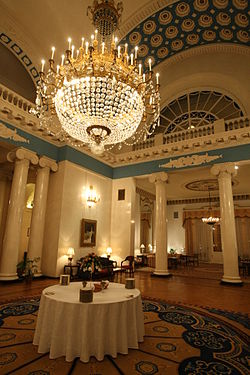Spaso House
The Spaso House ( Russian Особня́к Вто́рова or Спа́со-ха́ус ) is a neoclassical building in the Russian capital Moscow . It now serves as the residence of the US ambassador . For more than three quarters of a century it has reflected the relations between the USA and the former Soviet Union and today's Russia .
history
The building was built in 1913 in the Arbat district on 10 Spasopeskowskaya Square (hence the name) for the industrialist Nikolai Alexandrovich Vtorov , one of the richest men in Tsarist Russia. The area of the property is approximately 7,200 square meters. Older houses on the same square went up in flames in the Moscow fire in 1812 . The architects Wladimir Adamowitsch and Wladimir Mayat were influenced by the now defunct Gagarin House , built in the 1820s by Joseph Bové , and by the Italian Palladianism of the 16th century.
Soon after its completion, the owner died in unknown circumstances, his family fled Russia and was expropriated. The building served as a residence for the Soviet People's Commissar and Foreign Minister Georgi Wassiljewitsch Tschitscherin .
When the United States diplomatically recognized the Soviet Union in 1933 and the two states exchanged diplomats, the Soviet government was only able to propose a few buildings due to the dramatic shortage of office and housing space. The first newly appointed ambassador, William C. Bullitt , chose the building, among other things, because it had modern heating. George F. Kennan , later Ambassador to Moscow and at the time with the rank of Third Secretary and sent to Moscow as a Russian-speaking vanguard, negotiated with the Soviet authorities and a three-year lease was agreed. Ambassador Bullit had the plan to build a new building soon, but this failed because of the Soviet authorities. In 1934 the Spaso House was initially used as an embassy and residence, as the embassy building had not yet been renovated. In 1935, a large ballroom was set up to provide the festive setting for legendary parties. From July 1935 onwards there was increasing tension between the two governments and the Great Terror in Moscow, and the festivities in Spaso House decreased. Nevertheless, there were glamorous events such as a performance of his work The Love of the Three Oranges, conducted by Sergei Prokofiev himself . Because of the scarcity of food, the diplomats were often and for a long time dependent on the import of food; Ambassador Joseph E. Davies , married to a wealthy heiress , once brought large quantities of ice cream to the residence on his private yacht.
After the outbreak of the German-Soviet War in June 1941, the Soviet government and the embassies were evacuated to what is now Samara ; What remained was a team of six under Llewellyn E. Thompson , who later became ambassador to Moscow. In August 1945, the future US President Dwight D. Eisenhower celebrated the victory over Nazi Germany together with the Soviet government.
When George F. Kennan came to Moscow in 1952 as ambassador at the time of the Korean War , he discovered that the Soviet government had built a brick wall around the house on three sides and a massive gate on the entrance side. In the following year, 1953, under Ambassador Charles Bohlen , things relaxed somewhat after Stalin's death and Soviet journalists accepted the invitation again. Since 1954, Nikita Sergejewitsch Khrushchev was seen as a new strong man on the national holiday.
On May 26, 1972, President Richard Nixon came to Moscow to sign the ABM Treaty . On Independence Day 1976, the building reached its previous maximum with 3,000 invited guests.
In 1986 Spaso House experienced a special climax when the American pianist Wladimir Horowitz, who was born in the Russian Empire, made a guest appearance here with his specially flown in piano. The Juilliard String Quartet , the singer Thomas Hampson and many representatives of jazz also attracted numerous music-loving Muscovites. In May 1988 Ronald Reagan and General Secretary Mikhail Sergeyevich Gorbachev met here . In 1992 Moscow was hit by a severe food shortage; Ambassador Robert Schwarz Strauss insisted on offering guests like President Boris Nikolajewitsch Yeltsin homemade nachos on March 2nd .
Most recently, Spaso House hosted a US president, George W. Bush, on April 25, 2007, at the state funeral for Yeltsin.
Web links
literature
-
Charles W. Thayer : Bears in Caviar , Scherz, Bern; Munich; Vienna 1971, most recently Goldmann, Munich 1978, ISBN 3442033411 (memories)
- Original edition: Bears in the caviar , Lippincott, Philadelphia 1951
- US Embassy Moscow: Spaso House, 75 years: A short History , Moscow 2008 (engl.)
- Spaso House History online on the portal of the US Embassy Moscow
Individual evidence
- ^ Spaso House. US Embassy & Consulates in Russia. Retrieved April 8, 2018 .
- ^ Official page of the embassy on history , accessed on May 16, 2011
- ^ Official page of the embassy on history , accessed on May 16, 2011
- ^ Official page of the embassy on history , accessed on May 16, 2011
Coordinates: 55 ° 45 ′ 2 " N , 37 ° 35 ′ 17" E

